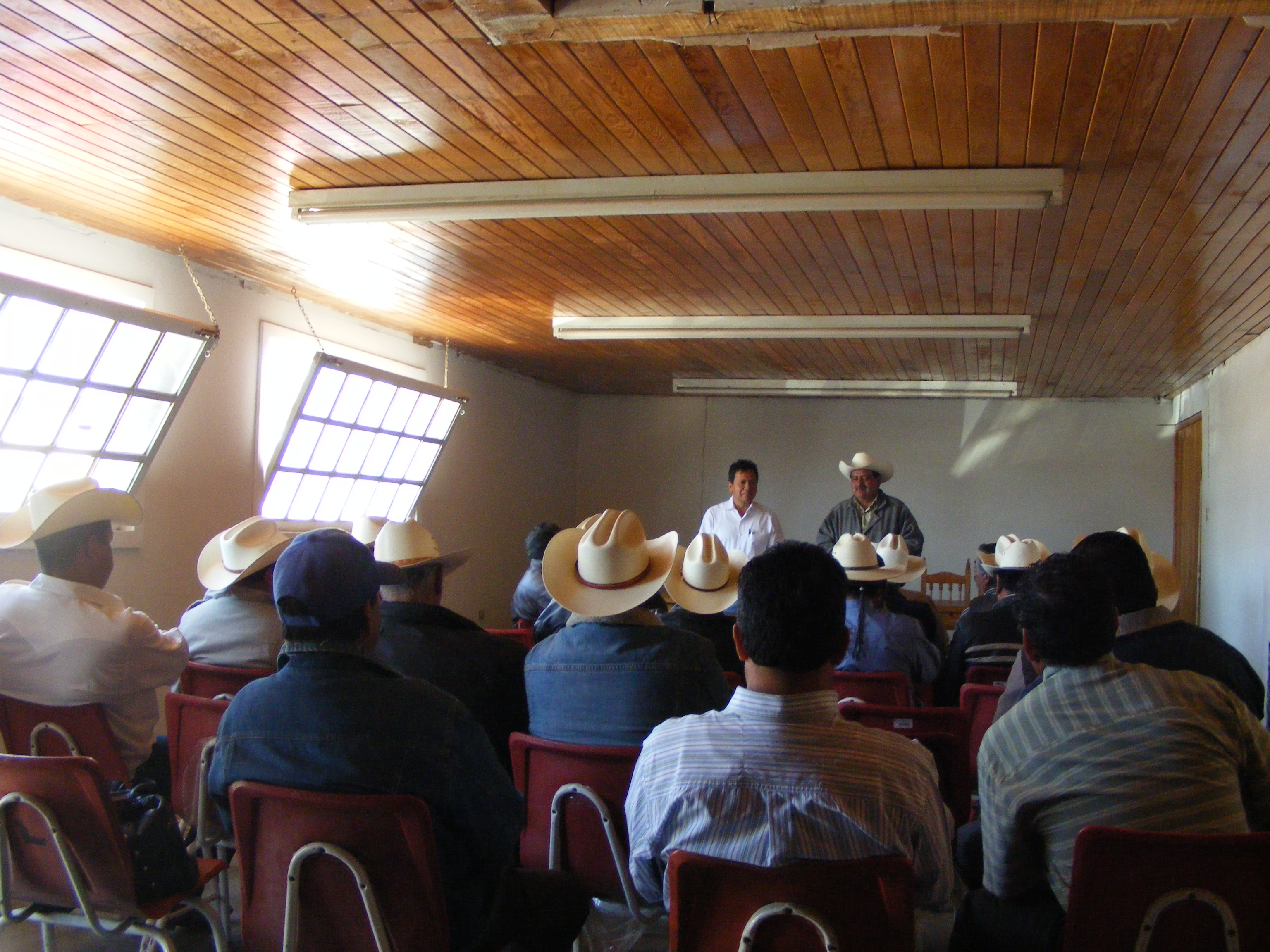The experience of Mexico, a global pioneer in community forestry, highlights the possibilities and challenges of commons as alternative forms of more just and sustainable socio-ecological regimes.*
The experience of community forestry in Mexico, a global pioneer in common property arrangements in forest regions, highlights the possibilities of commoning as alternative forms of social organization, economic production and ecological protection. At the same time it underscores, on one hand, the challenges of commons within an extractivist, developmentalist system that continually pushes for commons’ enclosures, and on the other, the necessity of social struggles to defend and rebuild those commons. The case has interesting parallels with some of the cases discussed in other of the manual entries in this blog, such as that of Chile’s extractivist regime of Eucalyptus plantations in indigenous Mapuche land; the struggles around waste contamination in the region of Campania, and the social economy initiatives in the Basque Country and Athens (to be published later on the blog).
Mexican forest commons as a model of sustainability
Approximately 52% of Mexico’s entire territory and 70% of its temperate forests – the highest percentage in the world – are estimated to be under collective property regimes known as ejidos (peasant communities) and comunidades (indigenous communities). Approximately 14 million people live in more than 8.000 forest’s communities and most of their livelihoods depend on forests resources. About 20% of these communities currently manage forests on their own for timber, while many others do so for non-timber forest products, ecotourism, and conservation, among others.

The temperate pine forests of the Sierra Madre Occidental mountain range in the state of Durango. Source: Gustavo García López.
In collective properties, decisions are taken collectively through the general assembly, the primary decision-making body of the community, which in most communities holds monthly meetings. Every three years, the community elects a governing council (comisariado) that officially represents the community, and an oversight council (consejo de vigilancia) in charge of monitoring the governing council, forest management activities and overall rule compliance.
Communities that engage in forestry activities are legally required to hire a certified forester (a sort of private ‘extension service’) to develop a management plan to be approved first by the general assembly and then by the government’s environmental ministry. The forest management plan, usually for a period of ten years, establishes a maximum allowable volume of timber (or non-timber product) to be harvested every year, with the goal of sustaining output in the long term. It also identifies the areas to be conserved for other uses and ecological restoration activities to be carried out, such as reforestation, soil conservation, and fire prevention. The economic benefits of timber harvesting and other economic enterprises (e.g. ecotourism) are shared equally amongst the community members. In this sense, the operation resembles small cooperatives.
In many ways, Mexico’s community forestry has been a successful experiment, leading some to call it a global model and for its replication in other countries. Research has shown that communities that have developed an active social and economic activity around forestry (e.g. timber extraction, ecotourism) have lower levels of deforestation than government-run protected areas as well as other non-communally managed forests. Community forestry has also contributed in some regions to reduction of poverty and to the development of strong social ties. Moreover, through social solidarity and livelihoods, forest commons have helped communities to adapt and respond in creative ways to the challenges posed by the political economy they inhabit, often resisting pressures for enclosures. For instance, researchers in the state of Michoacan analyzed forest communities’ responses to the expansion of avocado crops (the ‘avocado boom’), grown for export to the USA, fostered by the North American Free Trade Agreement (NAFTA). Communities engaged with timber harvesting activities for the most part did not cut their forests to plant avocado, while communities that had no forestry activities deforested almost everything. Meanwhile, in the state of Guerrero, researchers found that a region where communities had developed community forestry and strong monitoring and enforcement around forests had avoided the problems of illegal timber harvesting and violence that marred a nearby region in the same state.

General assembly of the forest association in Durango. Source: Gustavo García López.
Beyond the local: Constituting and sustaining multi-level commons
The case of Mexico also shows the importance of connecting local commoning experiences with different levels of governance beyond the local for sustaining the commons. These connections include inter-community organizations as well as collaborators from outside the communities, such as researchers, civil society organizations, and development agencies. These entities can provide political and economic support that fosters less dependence on the state.
Previous research has found that inter-community organizations that coordinate between multiple communities in a given region, help forest communities through political representation, channeling resources from government programs, pooling member resources for developing collective timber enterprises, and harmonizing ecological protection activities. For instance, in Oaxaca, with the longstanding support of a local civil society organization (GAIA) and financing from the Global Environmental Fund and the United Nations Development Program, the Community System for Biodiversity (SICOBI) brought together five forest communities from the southwest region in 2001 to establish regional watershed-level initiatives to improve livelihoods and better conserve land, water an biodiversity. With this project, member communities have been supported in developing community territorial plans and improving land management practices. Aside from strengthening community forestry, SICOBI has also helped establish pesticide-free agroforestry and shade-grown coffee initiatives to diversity local production while also conserving traditional maize as well as forestlands.
At the same time, national peasant forest organisations that provide a unified voice, such as Red Mocaf, as well as allied civil society organizations, such as the Mexican Civil Council for Sustainable Forestry (CCMSS), have played a crucial supporting role in demanding changes in federal policies and programs to guarantee support for, and defend the rights of, forest communities.

Tree nursery of forest association in Durango. The association provides these locally-adapted saplings at a low cost for member communities’ reforestation activities. Source: Gustavo García López.
A turbulent history: Between enclosures, rebellions and accomodations
The successful development of the commons in Mexico was not a conflict-free process. Forest commons emerged and evolved as a direct result of a revolutionary process and the social mobilizations, which peasants and indigenous groups have recurrently used to expand and defend these commons and pressure the state to support them. The initiatives that can be observed today, including the Zapatista movement, are part of a much longer history of struggle.
During the Porfirio Díaz dictatorship (1884-1911), Mexican forests suffered the classic fate of enclosures for large-scale economic projects by powerful corporations. Díaz sought to promote substantial investments by private foreign (mostly US) capital. For this purpose
he passed a law in 1883 which declared all “unproductive lands” (baldíos) as property of the state to be ‘developed’ by private investors for large-scale extractivist projects such as mining and timber – the same strategy used in Europe during the original wave of commons’ enclosures. Many of the lands declared as unproductive were inhabited by indigenous groups and peasants.
The Mexican revolution (c. 1910-1920) – the first in the world in the 20th century – led to the largest and longest-standing land reform process of the century, embodied in Article 27 of the 1917 Constitution. Over a period of 60 years, the state distributed millions of hectares of land in collective property to groups of landless peasants and indigenous communities. The Mexican state’s recognition of common property regimes in the Constitution and a series of federal laws, as well as programmatic support providing capacity building and resources for the development of community forestry activities, were crucial for today’s success of community forestry.
However, this state support was not automatic, but another outcome of the revolutionary struggle. While the Revolution opened the door for the collective land grants in the 1930s under the presidency of Lázaro Cárdenas, land reform quickly faced obstacles with changes towards more conservative presidencies after Cárdenas. The government’s strategy for managing forests quickly became anti-commons: a combination of conservation areas where any kind of community use of the forest was prohibited; and industrial-scale extractivist concessions given first to private corporations and then to public ones. This system proved a total failure in sustaining either forests or rural livelihoods.
Peasant struggles across the country led to the reigniting of significant land reform in the 1960s-70s; to a series of government programs to support community forestry; and to the end of the timber concessions in 1986. Many community forestry enterprises and inter-community forest organizations emerged in this period; they established the collective organizational basis of what today is considered a model initiative.
Yet as in the rest of the world, the 1990s brought neoliberal reforms to agrarian and environmental laws and policies. Common property was perceived as inefficient; privatization was promoted as the only ‘solution’ to ‘modernize’ the agricultural sector. Land reform was officially ended and ejidos were allowed to privatize their land. Free trade agreements with Chile (MCFTA) and with US and Canada (NAFTA) opened the door to the influx of cheaper forest products into Mexico. Despite a large community forestry program developed by the Mexican government with financing from the World Bank and the Global Environmental Fund, in the balance, the political economy of the new neoliberal regime has proved a great challenge to the forest commons.
Deforestation continues at high levels in many regions – between 2000 and 2012, almost 2 million hectares of forest were deforested in the country – and social, political and economic conditions for rural communities continue to deteriorate. Most forest communities still do not have organized self-management of their forests; many are under rentist contracts under which private corporations harvest timber with little economic benefit for locals. Land tenure conflicts and associated illegal logging from timber mafias also persist; in places like Michoacan and Guerrero, community leaders have been killed for defending their forests, as is happening in many places around the world.
Communities across the country have also started to de-collectivize forest management activities, forming what are called work groups (one of the institutions promoted by the neoliberal reforms), and to divest their collective forestry enterprises, selling off their timber processing infrastructure (e.g. sawmills). This is in significant part due to increasing costs of inputs and decreasing timber prices, strongly related to competition from the industrial timber plantations of Mexico’s ‘free trade’ partners; but also to government over-regulation of community forestry and lack of sufficient subsidies. A recent study by the Mexican Civil Council for Sustainable Forestry (CCMSS) calculated that complying with all relevant regulations can cost a community forestry enterprise hundreds of thousands of dollars and take up to two years. Another study by the CCMSS showed that the vast majority of government funding for forestry goes to timber plantations and reforestation activities, and not to community forestry.
In the last decade, the state’s response to these challenges has increasingly been one of neoliberal conservationist policies: most of the forest budget now goes to reforestation activities and payment for environmental services programs; and to increasing timber production through timber plantations and more intensive harvesting. This failed response is coupled with new processes of enclosure by the state and its corporate allies for large-scale extractivist activities – mainly mining and hydropower. Challenges to these new forms of dispossession have often been violently repressed. These challenges remind us that the commons require a structural change in order to flourish, and that meaningful state support comes through the pressure of social struggle.
In some regions, communities have faced this challenge through organized struggles to demand political and economic changes and continue to build grassroots alternatives. The best publicised is the Zapatista struggle, which emerged alongside NAFTA to challenge neoliberalism as the only possible form of governing. They sought to reclaim and defend the commons of the indigenous nations of Mexico by kicking out the government and political parties and recovering their traditional decision-making systems, where electoral processes are substituted by appointed positions deliberated in community assemblies. Resistance movements at local, regional and national levels have also sprung up to resist the dispossessions from the rapid expansion of extractivist-developmentalist projects; many of them came together in 2014 in a series of events “in defense of land, water and life” (Encuentro y Jornadas Nacionales en Defensa de la Tierra, el Agua y la Vida). These movements make explicit reference to the the radical social justice goals of Mexican revolutionaries Zapata and Villa.

Events organized by the Frente Autónomo Xochimilco in December 2014 commemorating the centenary of the Xochimilco Pact, where the revolutionary armies of Francisco “Pancho” Villa and Emiliano Zapata agreed to fight together for the Revolution’s then-forgotten goal of land reform. The movement’s slogan for these events reads “For the land, water, life, culture and autonomy of indigenous peoples (pueblos originarios)”. Source: frenteautonomox.org.
Meanwhile, in Oaxaca, which has the largest indigenous population in Mexico, communities have similarly fought for recovering historical self-governance systems, and today indigenous communities autonomously govern more than 70% of the state’s 570 municipalities (as contrast, in the entire country of Bolivia there are only 11 recognized autonomous indigenous municipalities). These communities often portray a rather different vision of ecology than the Western development model: nature is seen as Mother rather than product, development as a circular process between humans and ecology, rather than a linear process of ‘growth’. Oaxaca’s indigenous autonomy has served to support the durability of community and inter-community forestry organizations that in turn have sustained their forests and livelihoods for decades. In these struggles, we see that the recovery of the commons is also reclamation of community, territory and grassroots democracy.
Insights from the Mexican forest commons for civil society
The history of the Mexican forest commons debunks the hegemonic “tragedy of the commons” narrative; on the contrary, it shows marginalized communities are often at the forefront of protecting these commons. It also highlights that a broad redistribution over rights to land and its resources is an essential basis for commons. The Mexican revolution and subsequent peasant mobilizations that pushed the state to act made an important contribution in this regard –creating the institutional (legal, property) basis for commons initiatives. At the same time, we saw that even a ‘revolutionary’ pro-peasant state can have a tendency towards commons enclosures to facilitate capital accumulation; a process that has intensified under neoliberalism. Hence, there is a need for continuing struggles that go beyond the local and connect at regional and national levels to achieve structural changes. The participation of civil society organizations in these struggles can be pivotal, but it requires long-term involvement, dedication, commitment to mutual learning, and in-depth analysis of the structural constraints to commoning and the ways to transform them.
* This post is part of a series sharing chapters from the edited volume Political Ecology for Civil Society. Gustavo García López’s contribution is included in the chapter on “Commons”. We are eager to receive comments from readers and especially from activists and civil actors themselves, on how this work could be improved, both in terms of useful content, richness of examples, format, presentation and overall accessibility.
Further readings
Barsimantov, J., J. Navia-Antezana, 2012. Forest Cover Change and Land Tenure
Change in Mexico’s Avocado Region: Is Community Forestry Related to Reduced Deforestation for High Value Crops?. Applied Geography, 32, 844-853.
Bray, D. B., et. al., 2005. The Community Forests of Mexico: Managing for Sustainable Landscapes. University of Texas Press, Austin
Bray, D., 2013. When the state supplies the commons: Origins, changes, and design
of Mexico’s common property regime. Journal of Latin American Geography, 12(1), 33-55.
Durán, E., et. al., 2011. Multi-Scale Forest Governance, Deforestation, and Violence in
Two Regions of Guerrero, Mexico. World Development, 39, 611-619.
Garcia Lopez, G., A., 2013. Scaling up from the grassroots and the top down: the
impacts of multilevel governance on community forestry in Durango, Mexico. International Journal of the Commons, 7(2), 406-431.
Hart, J.M., 1999. Los norteamericanos en Durango, In: Cano Cooley, G., E., Cerutti,
M., (Eds.), Porfriato y Revolución en Durango. Instituto de Investigaciones Históricas,
Durango, Mexico, pp. 127-155.
Merino, L., Martínez, A., 2014. A vuelo de pájaro: Las condiciones de las comunidades
con bosques templados en México. Conaibo, Mexico City
Navarro, S., F., Bessi, R., 2014. Across Latin America, a Struggle for Communal Land
and Indigenous Autonomy. Truthout, July 20.
Civil society organizations working on forestry management issues
Consejo Civil Mexicano de Silvicultura Sostenible (CCMSS)
Red Mexicana de Organizaciones Campesinas Forestales (Red MOCAF)
Grupo Autónomo para la Investigación Ambiental (GAIA)
Grupo de Estudios Ambientales (GEA)




